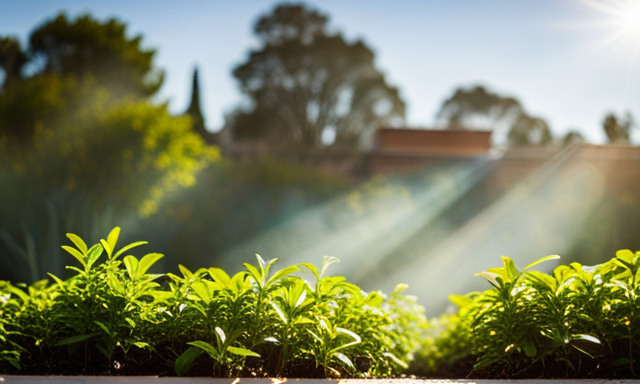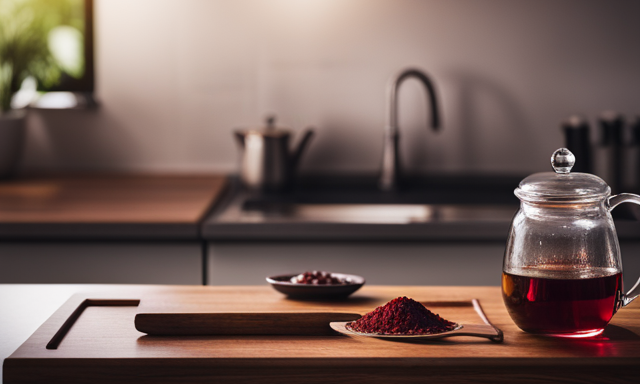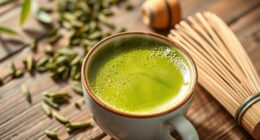Have you ever wanted to have your very own supply of delicious and healthy rooibos tea? Well, I have some great news for you! I have discovered a simple and rewarding way to grow your own rooibos tea right in your own backyard. Imagine the satisfaction of harvesting your very own leaves and brewing a cup of tea that you know came from your own hard work and dedication.
In this article, I will guide you through the process of growing rooibos tea step by step. From choosing the right seeds or seedlings to creating the perfect growing environment, I will share all the knowledge and tips you need to successfully cultivate your own rooibos plants. I will also teach you how to properly care for your plants, dry and process the leaves, and store and preserve your precious tea.
So, if you’re ready to embark on a rewarding journey of growing your own rooibos tea, let’s get started!
Key Takeaways
- Choosing the right seeds or seedlings from reputable suppliers is important for successful rooibos tea cultivation.
- Consistent moisture levels, adequate sunlight, and proper ventilation are crucial for nurturing young rooibos plants.
- Pruning, fertilizing, and pest control are essential for caring for rooibos plants.
- Harvesting and processing techniques, such as proper harvesting, drying, and storing methods, are crucial for obtaining high-quality rooibos leaves.
Understanding Rooibos Tea: A Brief Introduction
To fully appreciate the rich taste and numerous health benefits of Rooibos tea, you’ll need to familiarize yourself with its origins in South Africa and the intricate process of harvesting and oxidizing the leaves. Understanding rooibos tea is essential, as it offers a wide range of health benefits.
Packed with antioxidants, minerals, and essential nutrients, this herbal tea has been known to boost the immune system, promote digestion, and even relieve stress. Exploring the history of rooibos tea reveals that it has been consumed for centuries by the indigenous people of South Africa, who recognized its medicinal properties. Today, rooibos tea is enjoyed worldwide for its unique flavor and wellness benefits.
Now that we understand the importance of rooibos tea, let’s move on to choosing the right rooibos seeds or seedlings for successful cultivation.
Choosing the Right Rooibos Seeds or Seedlings
When selecting the perfect rooibos plant for your garden, it’s crucial to pick seeds or seedlings that are well-suited to your climate, just like how a person should choose a jacket that fits them properly for maximum comfort.
Seed selection is an important step in ensuring the success of your rooibos tea garden. Look for reputable suppliers who offer a variety of rooibos seed options, such as organic or heirloom varieties. Consider the germination rate and viability of the seeds before making a purchase. Propagation methods like seed stratification or scarification can also help improve germination rates.
Nurturing young rooibos plants requires attention to detail. Maintain consistent moisture levels, provide adequate sunlight, and protect the plants from extreme temperatures or pests.
By selecting the right seeds or seedlings and using proper propagation methods, you can lay a solid foundation for your rooibos tea garden.
Moving forward, let’s discuss creating the perfect growing environment.
Creating the Perfect Growing Environment
Imagine stepping into a lush oasis, where vibrant green leaves dance in the gentle breeze and the air is filled with the intoxicating scent of nature – this is the perfect growing environment for your precious rooibos plants.
Creating a grow room is a great option for those who don’t have access to a suitable outdoor space. By using hydroponic growing techniques, you can provide your rooibos plants with the optimal conditions they need to thrive.
Start by selecting a well-ventilated area with adequate space for the plants to grow. Set up grow lights to mimic natural sunlight and maintain a consistent temperature and humidity level. Additionally, ensure proper air circulation and water filtration to prevent any potential issues.
With a carefully controlled environment, you can nurture your rooibos plants from seedlings to maturity.
In the next section, we will explore the exciting process of planting and germinating rooibos seeds, taking your tea-growing journey one step further.
Planting and Germinating Rooibos Seeds
Creating the perfect growing environment for rooibos plants is essential for successful germination and growth. For example, a grow room with controlled temperature, humidity, and lighting can ensure that the rooibos seeds sprout and develop into healthy plants.
Germinating rooibos seeds can be a bit challenging, as they have a hard outer shell that needs to be scarified or scratched before planting. One effective method is to soak the seeds in hot water for a few minutes, then transfer them to a damp paper towel and place in a plastic bag. Keep the bag in a warm area and check regularly for signs of germination.
Once the seeds have sprouted, carefully transplant them into individual pots with well-draining soil. Caring for rooibos plants involves providing adequate sunlight, watering consistently, and fertilizing occasionally. By following these steps, you can ensure the successful growth of your rooibos plants.
Transitioning into the subsequent section, let’s now explore how to care for your rooibos plants.
Caring for Your Rooibos Plants
When it comes to caring for my rooibos plants, there are two key points that I focus on: pruning and shaping the plants, as well as fertilizing and pest control.
Pruning and shaping the plants is important to maintain their overall health and shape. I make sure to remove any dead or damaged branches to encourage new growth.
As for fertilizing, I use a balanced organic fertilizer to provide the necessary nutrients for my plants to thrive.
Lastly, I pay close attention to pest control. I regularly inspect my plants for any signs of pests and take appropriate measures to keep them at bay. This includes using natural pest repellents and removing any infested leaves or branches.
Pruning and Shaping the Plants
To ensure healthy growth and abundant harvest, you’ll want to regularly prune and shape your rooibos tea plants. Pruning techniques are essential for maintaining the plant’s shape and encouraging new growth.
Start by removing any dead or damaged branches, cutting them back to the base of the plant. This will promote healthier growth and prevent disease. Additionally, thin out any overcrowded areas to allow for better air circulation and sunlight penetration.
When shaping your rooibos plants, consider the desired form and size. You can achieve a bushy, compact shape by trimming back the tips of the branches. Alternatively, if you prefer a taller and more open plant, selectively prune the lower branches. By employing these pruning and shaping strategies, you’ll create a strong and visually appealing rooibos tea plant.
Moving on to fertilizing and pest control, it’s important to maintain a balanced soil and protect your plants from harmful insects and diseases.
Fertilizing and Pest Control
Maintaining a balanced soil and protecting your plants from harmful insects and diseases is crucial in ensuring the health and productivity of your rooibos tea plants. Did you know that a single pest can destroy up to 40% of a crop? To keep your plants thriving, here are some fertilizing techniques and organic pest control methods to consider:
Fertilizing techniques:
- Use a balanced organic fertilizer to provide essential nutrients to the soil.
- Apply the fertilizer in early spring and late summer to promote healthy growth.
Organic pest control:
- Encourage natural predators like ladybugs and lacewings to control pests.
- Use neem oil or insecticidal soap to treat infestations, ensuring they’re safe for consumption.
By following these fertilizing techniques and implementing organic pest control methods, you can ensure the health and productivity of your rooibos tea plants.
Now, let’s transition into the subsequent section about harvesting rooibos leaves.
Harvesting Rooibos Leaves
When it comes to harvesting rooibos leaves, there are a couple of key points to keep in mind. First and foremost, it’s important to know when the leaves are ready to be harvested. This typically happens during the summer months when the plants have reached their maximum growth.
Secondly, it’s essential to use proper techniques for leaf harvesting to ensure the best quality leaves. This involves carefully plucking the leaves by hand and avoiding any damage to the plant.
By following these guidelines, you can ensure a successful rooibos leaf harvest.
Knowing When to Harvest
Harvesting your own rooibos tea brings a sense of satisfaction and accomplishment to any tea lover. When it comes to knowing when to harvest, there are a few signs of maturity to look out for.
First, the leaves should have a vibrant red color. This indicates that they’ve reached their optimal harvesting time.
Second, the leaves should be fully grown and plump, with a slight curl.
Lastly, the aroma of the leaves should be strong and fragrant.
Once you’ve identified these signs, it’s time to move on to the harvesting techniques. Gently pluck the leaves from the stem using your fingers, being careful not to damage the plant. This’ll ensure that the leaves maintain their quality and flavor.
With the leaves harvested, let’s explore the proper techniques for leaf harvesting.
Proper Techniques for Leaf Harvesting
Once you’ve identified the signs of maturity, it’s time to dive into the exciting world of harvesting techniques for your precious rooibos leaves!
Leaf preservation is essential to maintain the flavor and quality of your tea. The traditional method involves hand-plucking the leaves, selecting only the top leaves and stems. However, there are alternative harvesting methods you can try.
One option is to use a sharp pair of shears to cut the rooibos branches about 2-3 inches below the tips. This method allows for faster harvesting and ensures a higher yield.
Another alternative is to use a mechanical harvester, which can be efficient for large-scale production.
Whichever method you choose, it’s crucial to handle the leaves gently to prevent bruising or damage.
Now that you’ve harvested your leaves, let’s move on to the next step of drying and processing rooibos leaves.
Drying and Processing Rooibos Leaves
When it comes to drying and processing Rooibos leaves, there are two main methods to consider: air drying and oven drying.
Air drying involves laying the leaves out in the sun to allow them to naturally dry over a period of time, while oven drying uses a controlled heat source to speed up the drying process.
Additionally, the fermentation and oxidation process is a crucial step in bringing out the unique flavor and color of Rooibos tea. During this process, the leaves are exposed to moisture and air, which triggers a chemical reaction that ultimately enhances the tea’s taste and aroma.
Air Drying vs. Oven Drying
While air drying your rooibos tea leaves may take longer, it allows the flavors to blossom like a delicate flower in the spring. Air drying techniques involve spreading the leaves in a single layer on a clean, dry surface and leaving them to dry naturally. This method preserves the natural flavors and aromas of the leaves, resulting in a more nuanced and complex tea. The gentle airflow during the drying process ensures that the leaves retain their vibrant color and delicate texture.
On the other hand, oven drying can be a quicker alternative, but it may result in a more uniform and less nuanced flavor profile. The heat from the oven can cause some of the delicate flavors to be lost.
Moving on to the next step, the fermentation and oxidation process is crucial for developing the unique taste and aroma of rooibos tea.
Fermentation and Oxidation Process
To achieve the unique taste and aroma of rooibos tea, you’ll need to understand the crucial fermentation and oxidation process. Here are four key points to consider:
-
Understanding the benefits of fermentation and oxidation process in rooibos tea: Fermentation and oxidation are essential steps in the production of rooibos tea. They not only enhance the flavor and aroma but also play a role in the development of its characteristic reddish-brown color.
-
Exploring the impact of different fermentation levels on rooibos tea flavor profiles: The duration of fermentation can significantly influence the taste of rooibos tea. Longer fermentation periods tend to result in a richer, sweeter flavor, while shorter periods may produce a milder taste.
-
Exploring the impact of different oxidation levels on rooibos tea flavor profiles: Oxidation levels can also affect the flavor of rooibos tea. Higher levels of oxidation can lead to a more robust and earthy taste, while lower levels may result in a lighter and fruitier flavor.
-
Transition: By understanding the fermentation and oxidation process, you can now move on to the next step of storing and preserving your freshly grown rooibos tea.
Storing and Preserving Rooibos Tea
Storing and preserving rooibos tea is essential for maintaining its freshness and flavor, but how can you ensure it stays aromatic and delicious for a long time? Proper storage techniques and understanding the tea’s shelf life are key. Firstly, store your rooibos tea in an airtight container to prevent exposure to moisture, light, and odors. This will help preserve its natural aroma and taste. Secondly, keep the container in a cool, dry place away from direct sunlight and heat sources. These factors can degrade the tea’s quality over time. Lastly, be mindful of the tea’s shelf life, which is typically around two years. To help you keep track, here’s a table that outlines the recommended storage conditions for rooibos tea:
| Storage Condition | Ideal Range |
|---|---|
| Temperature | 50-70°F |
| Humidity | 40-60% |
| Light Exposure | Low |
| Odor Exposure | Minimal |
| Airtightness | Sealed |
By following these storing techniques, you can enjoy your homemade rooibos tea at its best. Now let’s move on to brewing and enjoying your delightful cup of tea.
Brewing and Enjoying Your Homemade Rooibos Tea
When it comes to brewing and enjoying homemade Rooibos tea, there are a few key points to consider. First, experiment with various brewing methods to find the perfect balance of flavors and strengths that suit your preferences.
Second, add flavors and enhancements, such as citrus zest or honey, to elevate the taste and aroma of your tea.
Lastly, be open to trying new techniques and ingredients to create a truly unique and personalized Rooibos tea experience.
Experimenting with Various Brewing Methods
Try different brewing methods to discover the perfect way for you to enjoy the rich, earthy flavors of your homegrown rooibos tea. Here are a few alternative brewing techniques to consider:
-
Cold brewing: Steep your rooibos tea leaves in cold water for several hours or overnight. This method produces a smooth and refreshing iced tea with less bitterness.
-
Steaming: Instead of boiling water, try steaming it and pouring it over your rooibos tea leaves. This gentle brewing method helps retain more of the tea’s delicate flavors and aromas.
-
Infusing with herbs: Add a sprig of mint or a slice of lemon to your rooibos tea during the brewing process. These additions can enhance the overall taste and provide additional health benefits.
Experimenting with different brewing methods allows you to customize your rooibos tea experience. Once you’ve found your favorite brewing technique, you can move on to adding flavors and enhancements.
Adding Flavors and Enhancements
Enhance your rooibos tea experience by adding flavors and enhancements such as a splash of honey or a dash of cinnamon, transforming your cup of tea into a cozy and aromatic treat. Did you know that adding a squeeze of lemon to your rooibos tea can boost its antioxidant properties by up to 80%? To further explore the world of flavor infusion, try experimenting with other ingredients like ginger, mint, or vanilla. These additions can not only elevate the taste of your tea but also provide additional health benefits. For example, ginger can help with digestion, mint can soothe an upset stomach, and vanilla can promote relaxation. Get creative and discover your own unique flavor combinations. Incorporate these enhancements into your rooibos tea routine to discover a world of delicious and healthful possibilities. Now, let’s move on to sharing your rooibos tea journey with others.
Sharing Your Rooibos Tea Journey with Others
Share your rooibos tea journey with others and inspire them to embark on their own flavorful adventure.
One of the joys of growing your own rooibos tea is sharing your experiences with others. By sharing the process of growing, harvesting, and brewing your own tea, you can engage with the community and create a sense of camaraderie.
Start by hosting tea tastings or workshops where you can showcase the unique flavors and health benefits of rooibos tea. Share tips and techniques for growing and brewing, and encourage others to share their own experiences.
Create an online platform or social media group where tea enthusiasts can connect, exchange ideas, and support each other.
By sharing your rooibos tea journey, you can build a vibrant and engaged community of tea lovers.
Frequently Asked Questions
Can rooibos tea be grown in any climate?
Rooibos tea can only be grown in specific climates due to its cultivation challenges. The ideal conditions for growing rooibos tea include a Mediterranean climate with well-drained soil, moderate temperatures, and plenty of sunlight.
How long does it take for rooibos seeds to germinate?
Rooibos seeds typically take around 7-10 days to germinate. Once they sprout, growing rooibos tea requires proper care, including regular watering and pruning. Harvesting the leaves can be done after 12-18 months, followed by processing techniques to create various flavors, health benefits, and recipes.
Can rooibos plants be grown indoors?
Growing rooibos plants indoors offers numerous benefits. Not only can you cultivate rooibos tea in the comfort of your home, but it also allows for year-round growth and easier control of environmental factors.
What are some common pests or diseases that can affect rooibos plants?
Pest management and disease prevention are crucial for healthy rooibos plants. Common pests include aphids, spider mites, and caterpillars, while diseases like root rot and powdery mildew can also occur. Regular monitoring, proper watering, and organic insecticides can help protect the plants.
Are there any special techniques for drying and processing rooibos leaves to enhance the flavor?
To enhance the flavor of rooibos leaves, proper drying and processing techniques are crucial. After harvesting, the leaves should be bruised and left to ferment, which deepens the flavor. Then, they are sun-dried and finely cut, resulting in a delicious and aromatic rooibos tea.
Conclusion
In conclusion, growing your own rooibos tea is a rewarding and fulfilling journey. By following the steps outlined in this article, you can nurture your own little tea garden and enjoy the delicious flavors of homemade rooibos tea.
Just like a seed that grows into a beautiful plant, your passion for rooibos tea will flourish as you care for your plants and witness the transformation from leaves to a soothing cup of tea.
So, grab your gardening tools and let your rooibos tea adventure begin!










